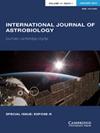信息获取作为评估生物签名任务的工具
IF 1
4区 物理与天体物理
Q3 ASTRONOMY & ASTROPHYSICS
引用次数: 0
摘要
我们提出了信息增益的数学概念,作为定量评估生物签名任务价值的一种方法。这使得确定任务价值如何取决于设计参数、先验知识和输入假设变得简单。我们通过将该框架应用于大量案例来证明其实用性:确定作为环境变量函数的信号发生率趋势所需的最小样本数,以及应为每类对象分配多少成本;假阳性和假阴性的相对影响,对恩克拉多斯数据的应用,以及如何最好地组合两个信号;在寻找潜伏者或其他空间受限信号的过程中,分辨率和覆盖率之间的最佳折衷,应用于我们目前对太阳系天体的了解;推断可居住性边界的最佳方法;用于不同任务方面的最佳资金数额;何时在任务中增加一项文书;最佳任务寿命;以及何时遵循/质疑可居住性模型的预测。在每种情况下,我们都会为优化任务设计、任务选择和/或目标选择提出具体、定量的建议。本文章由计算机程序翻译,如有差异,请以英文原文为准。
Information gain as a tool for assessing biosignature missions
We propose the mathematical notion of information gain as a way of quantitatively assessing the value of biosignature missions. This makes it simple to determine how mission value depends on design parameters, prior knowledge and input assumptions. We demonstrate the utility of this framework by applying it to a plethora of case examples: the minimal number of samples needed to determine a trend in the occurrence rate of a signal as a function of an environmental variable, and how much cost should be allocated to each class of object; the relative impact of false positives and false negatives, with applications to Enceladus data and how best to combine two signals; the optimum tradeoff between resolution and coverage in the search for lurkers or other spatially restricted signals, with application to our current state of knowledge for solar system bodies; the best way to deduce a habitability boundary; the optimal amount of money to spend on different mission aspects; when to include an additional instrument on a mission; the optimal mission lifetime; and when to follow/challenge the predictions of a habitability model. In each case, we generate concrete, quantitative recommendations for optimizing mission design, mission selection and/or target selection.
求助全文
通过发布文献求助,成功后即可免费获取论文全文。
去求助
来源期刊

International Journal of Astrobiology
地学天文-地球科学综合
CiteScore
3.70
自引率
11.80%
发文量
45
审稿时长
>12 weeks
期刊介绍:
International Journal of Astrobiology is the peer-reviewed forum for practitioners in this exciting interdisciplinary field. Coverage includes cosmic prebiotic chemistry, planetary evolution, the search for planetary systems and habitable zones, extremophile biology and experimental simulation of extraterrestrial environments, Mars as an abode of life, life detection in our solar system and beyond, the search for extraterrestrial intelligence, the history of the science of astrobiology, as well as societal and educational aspects of astrobiology. Occasionally an issue of the journal is devoted to the keynote plenary research papers from an international meeting. A notable feature of the journal is the global distribution of its authors.
 求助内容:
求助内容: 应助结果提醒方式:
应助结果提醒方式:


